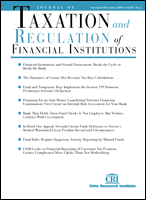Complete Issue
Author: Houman Shadab.
Source: Volume 27, Number 02, November/December 2013 , pp.1-60(60)

< previous article |return to table of contents
Abstract:
Our first article provides a comprehensive examination of the increasingly important topic of private equity fund management fee waivers, which can lead income to be taxed at capital gains rates instead of ordinary income rates. Authors Saba Ashraf and Alyson K. Pirio provide background on fee waiver agreements, discuss recent comments by Internal Revenue Service (IRS) officials and the First Circuit Court of Appeals decision in Sun Capital, and note that whether fee waivers convert ordinary income to capital gains turns largely on the waiver’s timing and risk allocation. In our next article, Kathlyn L. Farrell discusses financial institutions’ compliance with rules to prevent unfair, deceptive, or abusive acts or practices—more commonly referred to as UDAAP. Ms. Farrell reviews the historical development of UDAAP regulation from its inception to the most recent embodiment in Consumer Financial Protection Bureau rules. She discusses several enforcement actions by prudential regulators, and provides guidance in ways financial institutions can improve their compliance programs to reduce the risk of UDAAP violations. One aspect of UDAAP principles that applies specifically to mortgage lenders is the Truth in Lending Act (TILA). Joseph Patry, in our third article, reviews the 2009 amendments to TILA, focusing on the ensuing litigation under Section (g) of the Act, which relates to the definition of a creditor, assignment of debt, and the location where note ownership is recorded. Next, Cynthia M. Krus, Lisa A. Morgan, and Darius I. Ravangard analyze the structure and regulation of business development companies (BDCs), which are a type of closed-end investment fund. BDCs are a growing but still relatively obscure investment vehicle that has the advantage of not being subject to the full scope of investment company regulation while still being available to retail investors. As the authors note, the fall 2003 structuring of TICC Capital as an externally managed BDC was a pivotal event that ultimately influenced the development BDCs in their non-traded and privately organized varieties. This issue concludes with James D. Goeller’s Community Banks column, which discusses an issue of concern not only to community banks, but more broadly to the industry: IRS Form 1099-C. The finding of the bankruptcy court in Reed that a bank-issued Form 1099-C (dealing with the tax consequences from the cancellation of debt) precluded any subsequent rights to collection or repayment differs from the IRS position. Mr. Goeller suggests that issuers of Form 1099-C may need to rethink their reporting position.Keywords: management fee waivers;IRC Sec. 707(a)(2)(A);FTC Act; CFPB; risk management;15 U.S.C. 1641(g); Mortgage Loan Transfer Notice; Truth in Lending Act; business development company;Form 1099-C
Affiliations:
1: New York Law School.